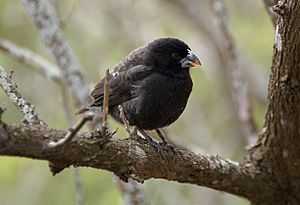Medium ground finch facts for kids
Quick facts for kids Medium ground finch |
|
|---|---|
 |
|
| Male | |
 |
|
| Female | |
| Conservation status | |
| Scientific classification | |
| Genus: |
Geospiza
|
| Species: |
fortis
|
 |
|
The medium ground finch (Geospiza fortis) is a type of bird that lives only on the Galapagos Islands. It belongs to the Thraupidae family. This bird is one of the famous Darwin's finches. Scientists have actually seen this bird species change over time, right before their eyes! These finches usually live in tropical shrubland areas.
Sometimes, when there are only a few medium ground finches, they can have problems. This happens when birds mate with others that are too closely related. It can make the group less healthy and reduce the variety in their genes.
Contents
About the Medium Ground Finch
Like other birds in its group, the medium ground finch looks different depending on if it's a male or a female. This is called sexual dimorphism. The female bird has brown, streaky feathers. The male bird is solid black, with white tips under its tail.
This finch is about 12.5 cm (4.9 in) long. This size is between the small and large ground finches. The bird's bill can be different sizes. However, the top part of the beak is always longer than how deep the beak is at its base. The shape of their wings can also change. This change is often due to different pressures from their environment. For example, male finches have shorter, rounder wings. This helps them fly better when they are trying to attract a female.
How They Change Over Time
In 1977, the Galápagos Islands had a very bad drought. A drought is when there is not enough rain. This meant there were fewer seeds for the finches to eat. The medium ground finch usually likes small, soft seeds. But because of the drought, they had to eat harder, larger seeds.
Birds with larger beaks could crack these tough seeds more easily. This was a strong pressure from nature. Because beak size can be passed down from parents to their young, the finch population changed. In the next generation, the average beak size of the medium ground finches became larger. This is an example of natural selection.
Scientists also saw changes in finches on Daphne Major island. This happened during another drought in 2004. At that time, a group of large ground finches (Geospiza magnirostris) had recently moved to the island. Both the medium and large ground finches ate the same types of seeds. This led to a lot of competition for food.
The large ground finches had bigger beaks and bodies. So, they were better at getting the seeds. To avoid competing with the larger finches, the medium ground finches with smaller beaks had a better chance to survive. This caused a big change. In the next generation, the medium ground finches started to have smaller beaks. This is how species can change to avoid competition.
Where They Live
The medium ground finch lives only on the Galápagos Islands. You can find them on ten different islands: Baltra, Floreana, Isabela, Fernandina, Seymour, Pinzón, San Cristóbal, Santa Cruz, Santa Fé, and Santiago.
What They Eat
The medium ground finch mostly eats seeds. But they also eat flowers, buds, and young leaves. Sometimes, they will eat an insect. They look for food on the ground or in low plants. In towns and cities, these birds often prefer to eat human food instead of their natural foods.
Health Challenges and Parasites
The medium ground finch can be affected by a fly called Philornis downsi. They can also get a bird virus called avian pox virus.
In 2008, there was a big outbreak of the avian pox virus. About half of the finches tested had the virus. Because of this, the finches have developed special defenses called antibodies. These antibodies help them fight off certain harmful parasites. Finches with more antibodies tend to be healthier and have more healthy young.
A study in 2015 used a new math model. It suggested that the population of 270,000 birds on Santa Cruz might disappear in 50 years. This is partly because of the Philornis flies. These flies lay eggs in the finch nests, even in the baby birds' nostrils. The fly larvae eat the living tissue of the baby birds. In bad cases, they can even make holes in the birds' beaks.
Scientists are looking for ways to help. One idea is to bring in tiny parasitic wasps. These wasps would lay their eggs on the fly larvae. Another idea is to use cotton wool treated with a special bug spray. The adult birds would then use this cotton to build their nests, which could help protect their babies.
See also
 In Spanish: Pinzón de Darwin picomediano para niños
In Spanish: Pinzón de Darwin picomediano para niños


